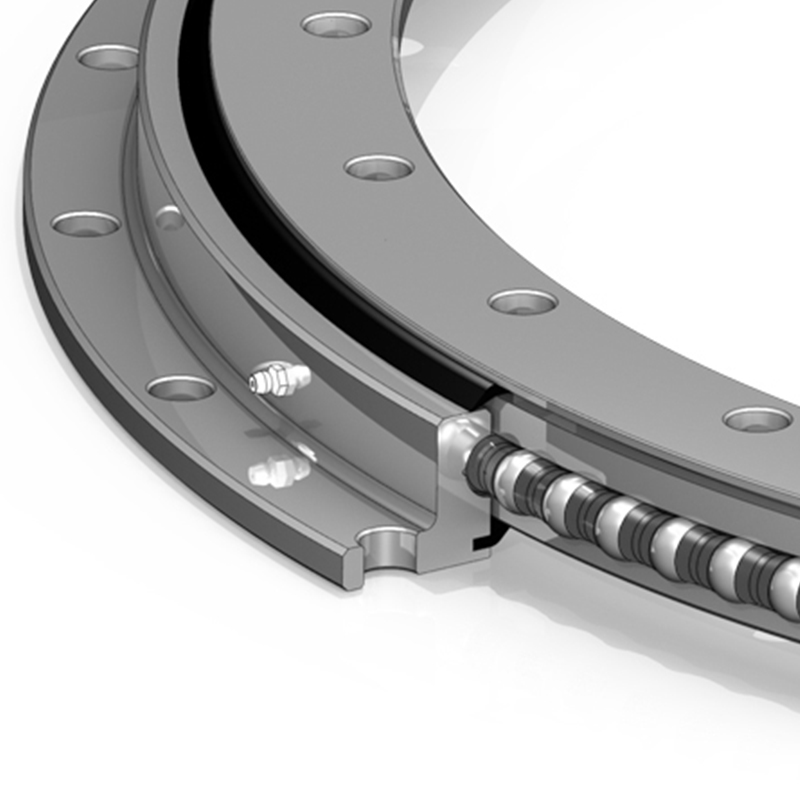What are Single Row Contact Ball Slewing Bearings?
A single row contact ball slewing bearing is a type of rotational bearing designed to accommodate axial, radial, and tilting moment loads. They are called "single row" because they feature a single row of balls positioned between two rings—an inner and an outer ring—allowing for smooth rotation. The ball bearings make contact with the raceways (tracks) on both the inner and outer rings, ensuring that the bearing can handle both high axial loads and low to moderate radial loads. They are often used in applications where space is limited but smooth rotation is required, and they allow for easy integration into various mechanical systems.
Flanged Four Contact Ball Slewing Bearing
Flange type slewing bearing also belongs to four-point contact ball slewing bearing.
Read More Get A Quote
Features of Single Row Contact Ball Slewing Bearings
High Load Capacity: They are capable of handling axial, radial, and tilting moment loads simultaneously.
Compact Design: The single-row design makes them suitable for applications with space constraints.
Smooth Rotation: The use of ball bearings ensures smooth, frictionless movement, even under heavy loads.
Versatility: These bearings can be used in a variety of applications, from low-speed to medium-speed machinery.
Self-aligning: The spherical ball arrangement can help compensate for minor misalignments between the inner and outer rings.
Easy to Mount: Due to the single-row configuration, they are relatively simple to install and maintain.
Durability: Made from high-quality materials, these bearings are durable and can function in demanding environments.
Types of Single Row Contact Ball Slewing Bearings
There are generally three types of single row contact ball slewing bearings based on the raceway geometry and their load-bearing characteristics:
Radial Ball Slewing Bearings: These are designed to handle radial loads and are suitable for lower axial loads.
Axial Ball Slewing Bearings: Primarily designed to accommodate axial loads, these bearings can also handle limited radial forces.
Combined Ball Slewing Bearings: These can handle both axial and radial loads, as well as tilting moments, making them more versatile for complex applications.
Applications of Single Row Contact Ball Slewing Bearings
Single row contact ball slewing bearings are used in a wide variety of industries and applications, including:
Construction Machinery: For example, cranes, excavators, and other heavy equipment require slewing bearings to facilitate smooth, rotational movements.
Solar Panels: Solar tracking systems use these bearings to enable the panels to track the sun’s movement.
Wind Turbines: Slewing bearings help in the rotation of the turbine blades for efficient energy generation.
Industrial Equipment: Machines requiring high load-bearing capacity with limited radial space, such as rotary tables, turntables, and indexing machines.
Material Handling Systems: Conveyor systems, palletizers, and other automated machinery use slewing bearings to facilitate efficient operation.
Robotics: In robotic arms or other automated machinery, the bearings help achieve precise rotation and positioning.
How to Select Single Row Contact Ball Slewing Bearings?
Selecting the right single-row contact ball slewing bearing involves considering several key factors:
Load Requirements: Assess the type and magnitude of the load (axial, radial, or tilting moments) that the bearing will need to support.
Speed and Rotation Angle: Determine the required rotational speed and the range of motion (how many degrees the bearing will rotate).
Environmental Conditions: Consider the operating environment (e.g., temperature, moisture, dust, chemicals) as this will impact the bearing material and design.
Size and Space: Ensure the bearing size matches the available space in the design.
Material: Choose a bearing made from materials that offer durability, corrosion resistance, and strength, especially if used in harsh environments.
Mounting and Alignment: Consider whether the bearing needs to accommodate misalignment between the rings or if additional alignment mechanisms are needed.
Maintenance: Choose a bearing design that allows for easy maintenance and replacement, if necessary.




